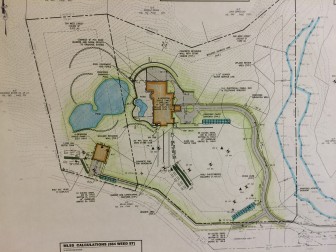A peer review of a dramatic plan to landscape extensively a Weed Street property is raising questions about a proposed 15,000-square-foot manmade pond.
The review, from Riverside-based D’Andrea Surveying & Engineering, focuses on site development and drainage management plans at 384 and 386 Weed St., a combined 7-acre parcel.
“What is the purpose of the pond and the justification for having to significantly alter over 50,000 square feet of wooded, moderate to steep slopes in order to create the 15,000-square-foot artificial pond?” Leonard D’Andrea writes in the peer review.
“There is very little design information provided for the proper construction of an artificial pond with an area of moderate slopes and below an area of steep slopes. The pond would contain about 5 feet of water. Are any other State level permits required for the construction of the 15,000-square-foot pond? … We suggest a Geotechnical Engineer be retained to analyze the soils, groundwater levels and slopes to determine if such a pond is feasible based on the design approach submitted by Landtech.”

Here’s a landscape architect’s rendering of the site plan for 384 and 386 Weed St. The pond at the property’s western end will require the removal of hundreds of mature trees. Courtesy of Sean Keating of Stamford-based TLC Lawn and Landscaping Service
The pond is to be built into a hillside on the property, and part of the landscaping plan calls for some 420 trees to come down—a detail that at a Planning & Zoning public hearing last month concerned some neighbors about runoff and preservation as well as the project’s feasibility and scope.
The overall development calls for construction of two dwellings, pool, the manmade pond, patio and storm water management and septic systems on contiguous lots.
At the regular meeting of the Inland Wetlands Commission Monday, the principal of an engineering firm doing work on behalf of the applicant said that nearly 600 trees will remain on the property and that the new trees to be planted will outnumber the existing ones planned for removal.
According to Peter Romano of Westport-based engineering firm Landtech, nearly 500 new trees will be planted at 384 and 386 Weed St.

Site plan for 384 and 386 Weed St. Courtesy of Juan Paredes of Landtech
“I’m talking about trees, actual deciduous and ornamental trees that are going to be placed on this piece of property– and then there’s 4,000 shrubs and perennials being constructed or installed on this piece of property, so the net of this is actually a better situation,” Romano said at the meeting, held in the Sturgess Room at the New Canaan Nature Center.
“It sounds terrible when you say you are taking down 380 trees, but you were out there and you saw the level of some of the trees. They are all secondary growth out there. I’m not diminishing the value of the trees, but I think at end of day we’re going to have a very nice project out there, in proximity to some wetlands that have already got a conservation easement around them.”
Given the public’s interest in the project—as well as the newness of the peer review from D’Andrea (it arrived late Monday afternoon)—the Inland Wetlands Commission voted 7-0 at its meeting to schedule a public hearing on developer Coastal Construction Group’s plans.
Technically, the April 27 special meeting will see two public hearings, one for plans at 384 Weed St. for construction of a new dwelling and a pond, the other for 386 Weed St. for a dwelling with patio and pool.
“I appreciate and respect the fact that you will bring this to a public hearing,” Romano said. “It is unfortunate that P&Z got raised to the level it did, but this is a single-family residence, which is allowed in New Canaan, with no encroachment into your regulated area. Keep that in mind.”
He added: “I understand the public has raised concerns about different things and it’s probably appropriate for you to go to a public hearing, but I would offer that we our client is going to be a neighbor to a lot of these people. He’s not coming in and doing something that is out of the ordinary. Everybody has developed single-family residences and that’s what we are going to do.”
The D’Andrea report notes that “only a minimal amount of sedimentation and erosion controls provided for the project that consists of extensive earth moving operations over moderate to steep slopes.”
“A single line of silt fence with staked hay bales is provided on the southerly side of the existing shared driveway that would be inundated under most rain events. This critical plan should be prepared in accordance with the Connecticut Guidelines for Soil Erosion and Sediment Control.”
Citing delays in town approvals due in part to weather-related meeting cancellations, attorney David Rucci, speaking on behalf of the applicant, requested that Inland Wetlands work toward addressing all concerns and hopefully closing the public hearing next month.
According to tax records, a single buyer purchased four contiguous lots on Weed Street last May and June.